| Solar eclipse of May 20, 2050 | |
|---|---|
 Map | |
| Type of eclipse | |
| Nature | Hybrid |
| Gamma | −0.8688 |
| Magnitude | 1.0038 |
| Maximum eclipse | |
| Duration | 21 sec (0 m 21 s) |
| Coordinates | 40°06′S 123°42′W / 40.1°S 123.7°W |
| Max. width of band | 27 km (17 mi) |
| Times (UTC) | |
| Greatest eclipse | 20:42:50 |
| References | |
| Saros | 148 (23 of 75) |
| Catalog # (SE5000) | 9619 |
A total solar eclipse will occur on May 20, 2050. A solar eclipse occurs when the Moon passes between Earth and the Sun, thereby totally or partly obscuring the image of the Sun for a viewer on Earth. A total solar eclipse occurs when the Moon's apparent diameter is larger than the Sun's, blocking all direct sunlight, turning day into darkness. Totality occurs in a narrow path across Earth's surface, with the partial solar eclipse visible over a surrounding region thousands of kilometres wide. This eclipse is a hybrid eclipse, starting and ending as an annular solar eclipse.
This hybrid eclipse is notable in that it does not hit land anywhere on Earth.
Related eclipses
Solar eclipses 2047–2050
This eclipse is a member of a semester series. An eclipse in a semester series of solar eclipses repeats approximately every 177 days and 4 hours (a semester) at alternating nodes of the Moon's orbit.[1]
Note: Partial lunar eclipses on January 26, 2047 and July 22, 2047 occur on the previous lunar year eclipse set.
| Solar eclipse sets from 2047–2050 | ||||
|---|---|---|---|---|
| Descending node | Ascending node | |||
| 118 | June 23, 2047 Partial |
123 | December 16, 2047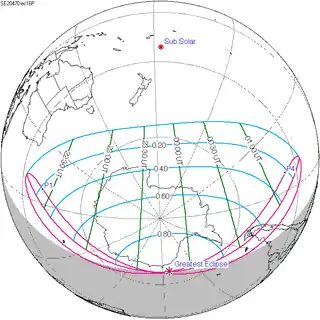 Partial | |
| 128 | June 11, 2048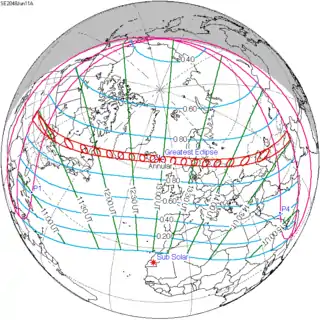 Annular |
133 | December 5, 2048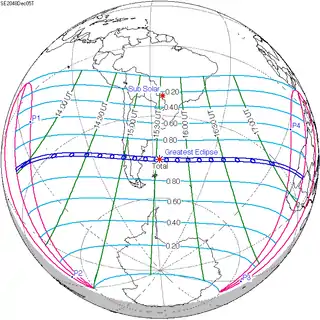 Total | |
| 138 | May 31, 2049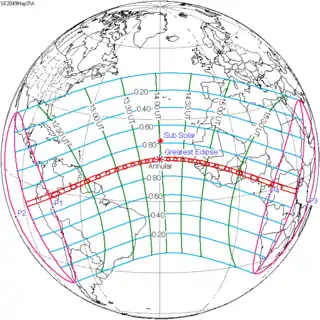 Annular |
143 | November 25, 2049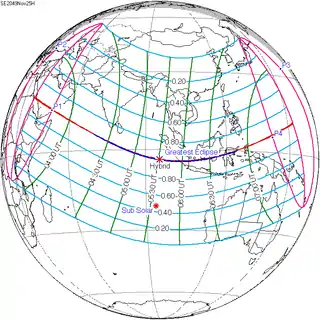 Hybrid | |
| 148 | May 20, 2050 Hybrid |
153 | November 14, 2050 Partial | |
Saros 148
Solar saros 148, repeating every about 18 years and 11 days, contains 75 events. The series started with a partial solar eclipse on September 21, 1653. It has annular eclipses on April 29, 2014, and May 9, 2032, and a hybrid eclipse on May 20, 2050. It has total eclipses from May 31, 2068, to August 3, 2771. The series ends at member 75 as a partial eclipse on December 12, 2987. The longest total eclipse will be on April 26, 2609, at 5 minutes and 23 seconds.[2]
| Series members 15–25 occur between 1901 and 2100: | ||
|---|---|---|
| 15 | 16 | 17 |
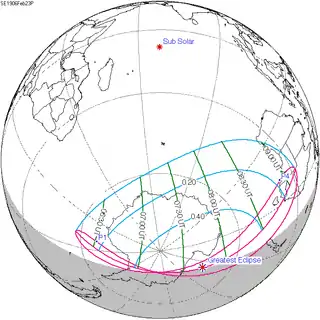 February 23, 1906 |
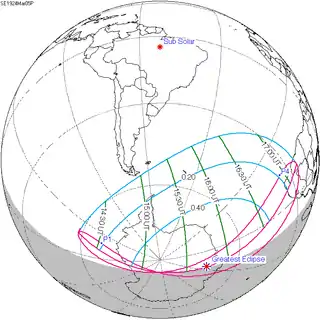 March 5, 1924 |
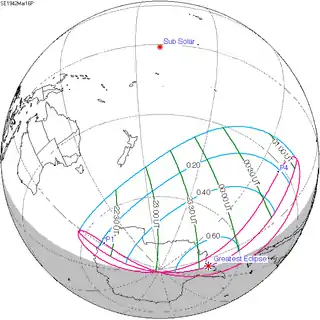 March 16, 1942 |
| 18 | 19 | 20 |
 March 27, 1960 |
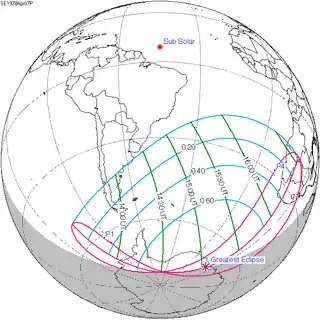 April 7, 1978 |
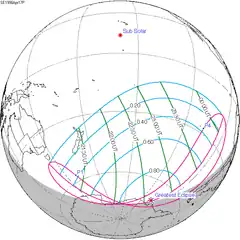 April 17, 1996 |
| 21 | 22 | 23 |
 April 29, 2014 |
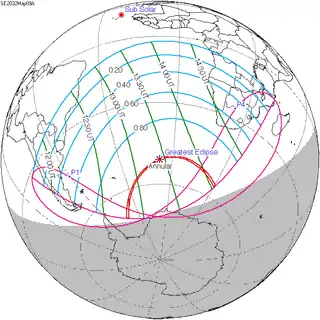 May 9, 2032 |
 May 20, 2050 |
| 24 | 25 | |
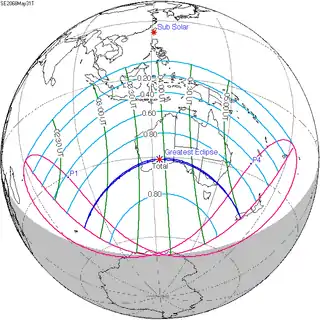 May 31, 2068 |
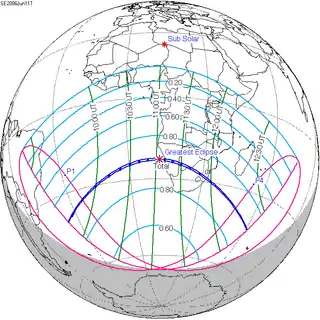 June 11, 2086 | |
Inex series
This eclipse is a part of the long period inex cycle, repeating at alternating nodes, every 358 synodic months (≈ 10,571.95 days, or 29 years minus 20 days). Their appearance and longitude are irregular due to a lack of synchronization with the anomalistic month (period of perigee). However, groupings of 3 inex cycles (≈ 87 years minus 2 months) comes close (≈ 1,151.02 anomalistic months), so eclipses are similar in these groupings. In the 19th century:
- Solar saros 140: total solar eclipse of October 29, 1818
- Solar saros 141: annular solar eclipse of October 9, 1847
- Solar saros 142: total solar eclipse of September 17, 1876
| Inex series members between 1901 and 2100: | ||
|---|---|---|
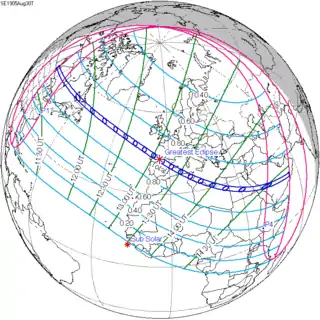 August 30, 1905 (Saros 143) |
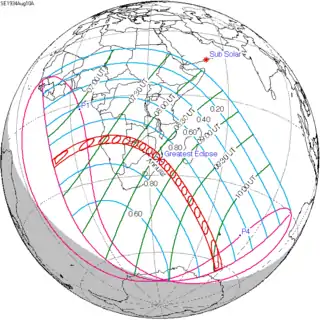 August 10, 1934 (Saros 144) |
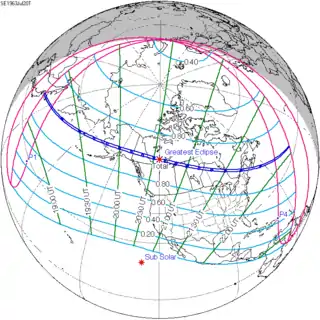 July 20, 1963 (Saros 145) |
 June 30, 1992 (Saros 146) |
 June 10, 2021 (Saros 147) |
 May 20, 2050 (Saros 148) |
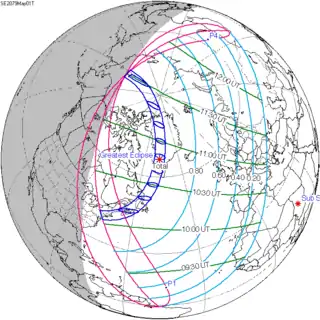 May 1, 2079 (Saros 149) |
||
In the 22nd century:
- Solar saros 150: partial solar eclipse of April 11, 2108
- Solar saros 151: annular solar eclipse of March 21, 2137
- Solar saros 152: total solar eclipse of March 2, 2166
- Solar saros 153: annular solar eclipse of February 10, 2195
Metonic series
The metonic series repeats eclipses every 19 years (6939.69 days), lasting about 5 cycles. Eclipses occur in nearly the same calendar date. In addition, the octon subseries repeats 1/5 of that or every 3.8 years (1387.94 days). All eclipses in this table occur at the Moon's descending node.[3]
| Octon series with 21 events between May 21, 1993 and August 2, 2065 | ||||
|---|---|---|---|---|
| May 20–21 | March 8–9 | December 25–26 | October 13–14 | August 1–2 |
| 98 | 100 | 102 | 104 | 106 |
| May 21, 1955 | March 9, 1959 | December 26, 1962 | October 14, 1966 | August 2, 1970 |
| 108 | 110 | 112 | 114 | 116 |
| May 21, 1974 | March 9, 1978 | December 26, 1981 | October 14, 1985 | August 1, 1989 |
| 118 | 120 | 122 | 124 | 126 |
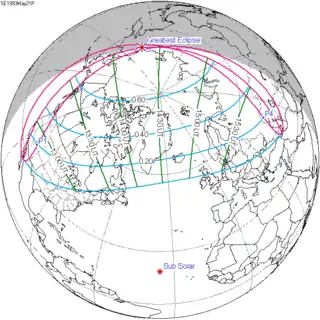 May 21, 1993 |
 March 9, 1997 |
 December 25, 2000 |
 October 14, 2004 |
 August 1, 2008 |
| 128 | 130 | 132 | 134 | 136 |
 May 20, 2012 |
 March 9, 2016 |
 December 26, 2019 |
 October 14, 2023 |
 August 2, 2027 |
| 138 | 140 | 142 | 144 | 146 |
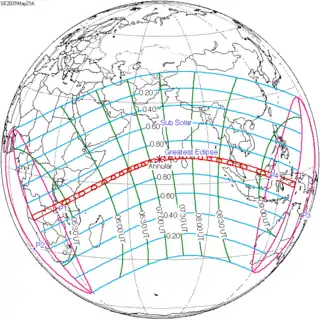 May 21, 2031 |
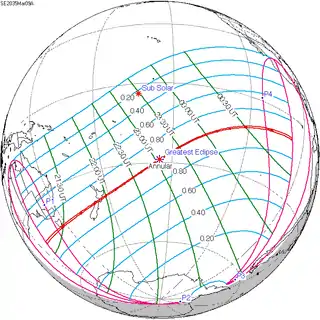 March 9, 2035 |
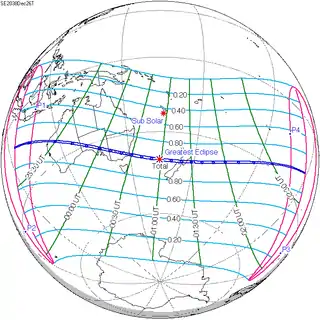 December 26, 2038 |
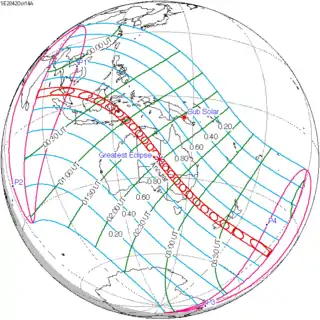 October 14, 2042 |
 August 2, 2046 |
| 148 | 150 | 152 | 154 | 156 |
 May 20, 2050 |
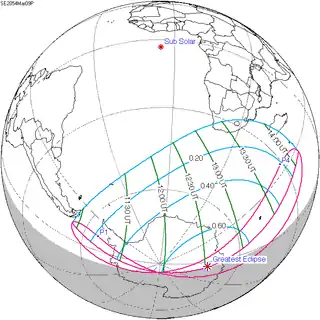 March 9, 2054 |
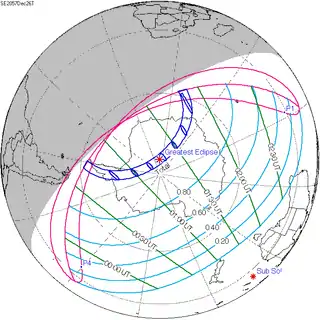 December 26, 2057 |
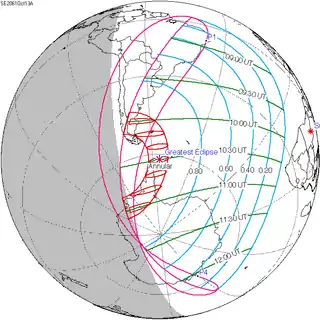 October 13, 2061 |
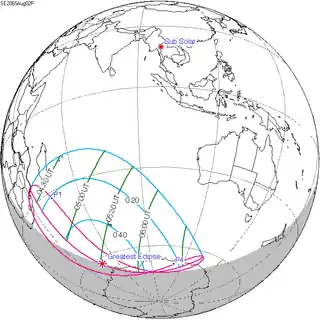 August 2, 2065 |
| 158 | 160 | 162 | 164 | 166 |
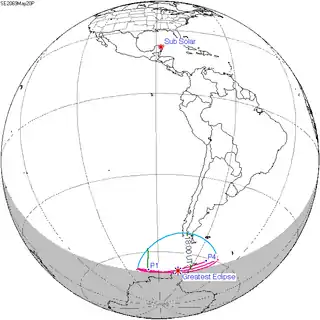 May 20, 2069 |
March 8, 2073 | December 26, 2076 | October 13, 2080 | August 1, 2084 |
Notes
- ↑ van Gent, R.H. "Solar- and Lunar-Eclipse Predictions from Antiquity to the Present". A Catalogue of Eclipse Cycles. Utrecht University. Retrieved October 6, 2018.
- ↑ Saros Series Catalog of Solar Eclipses NASA Eclipse Web Site.
- ↑ Note S1: Eclipses & Predictions in Freeth, Tony (2014). "Eclipse Prediction on the Ancient Greek Astronomical Calculating Machine Known as the Antikythera Mechanism". PLOS ONE. 9 (7): e103275. Bibcode:2014PLoSO...9j3275F. doi:10.1371/journal.pone.0103275. PMC 4116162. PMID 25075747.
References
- Earth visibility chart and eclipse statistics Eclipse Predictions by Fred Espenak, NASA/GSFC
.jpg.webp)

